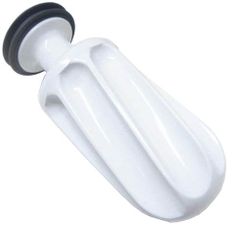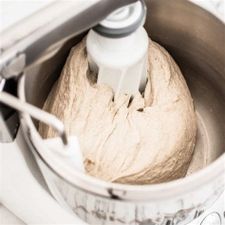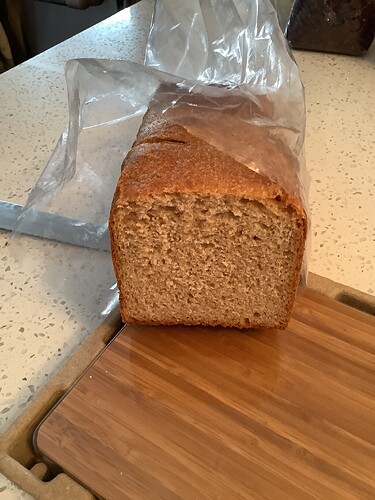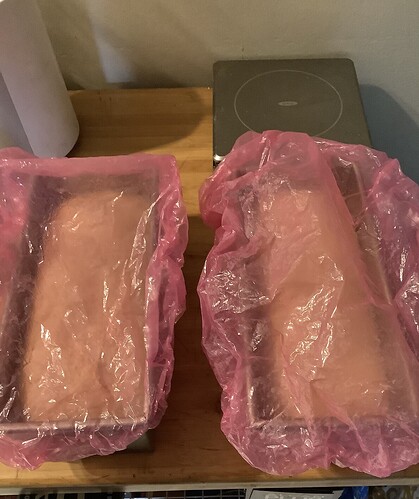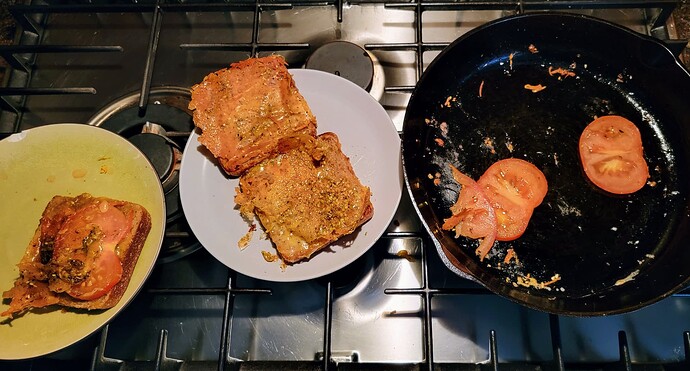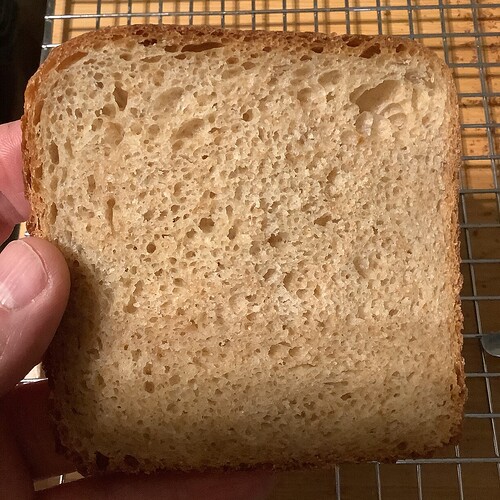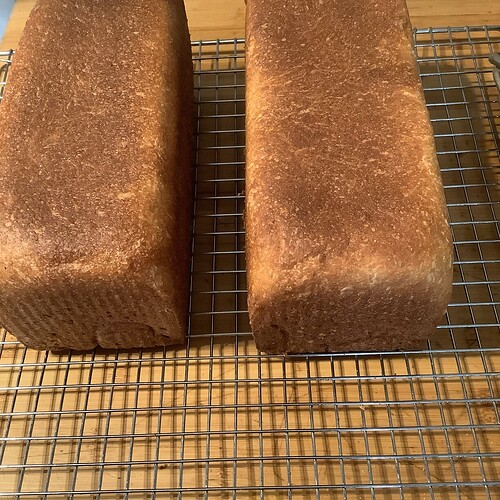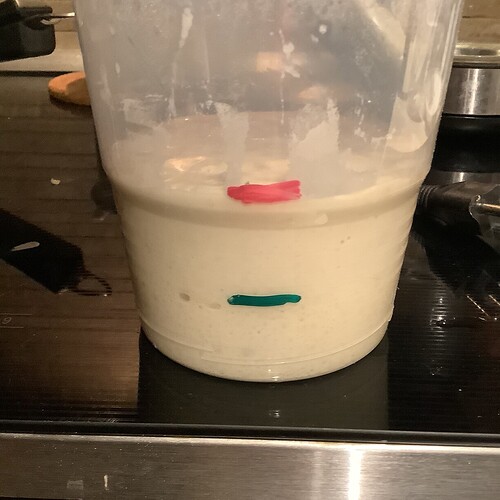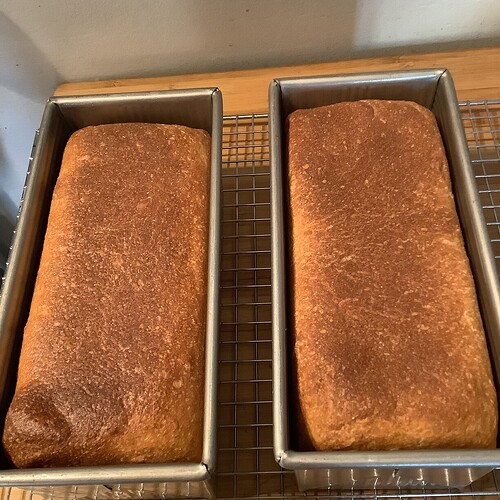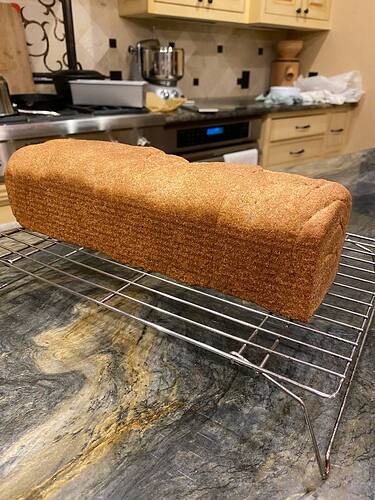What happened to my loaf?
I used Spelt and HWW. In line with @Fermentada ‘s counsel and according to the Sourdough to Yeast Conversion I made the scald with 50g HWW.
I used (internally thinking “Oh no, maybe this is what happened “)…
I meant to use
385g HWW (adding in 1/2 the sourdough weight in flour) and
445g warm milk and (adding in 1/2 the sourdough weight in liquid)
350g Spelt and
4-5g of yeast.
After the initial mixing the dough was anything but sticky. I came out easily by hand and was already in a ball.
Nonetheless I allowed it to rest for 30 minutes. After that time it was even more stiff so I decided I needed to go off-script to try to save this loaf. There was no way I could get a windowpane- the dough would tear with even the slightest attempt at a slap & fold.
I decided I must add milk. So I kneaded in milk until the dough became sticky. I used a few techniques to do this- including coil folding and tri-folding. As the dough loosened I was able to do some bench shaping (1/4 turn and pull towards me with a dough scraper, repeat). The dough was still not forming into a good boule with this technique- neither was it sticking to bare granite- it was sliding over the stone rather than catching and stretching.
Overall I added an unmeasured amount of milk (but at least 1/2 cup- tipping several tablespoons into the dough at intervals. The dough was beginning to get sticky so I stopped and covered it to develop for 3-4 hours.The shape was not a nice sphere as had been obtained in other recipes with this technique.
The dough did indeed double, but deflated almost immediately as I started to loosen it from the edges of the bowl. I failed to re-read the directions and more “laminated” the dough into a rectangle than ‘patted it out’. I rolled it up- it was too long but I scrunched the ends and placed in an ungreased USA Pan large Pullman.
In 2-3 hours it rose to the lip and I believe the lid may have touched a bit of dough in one spot as the lid rolled over. The loaf was baked according to the recipe. It was 201 at the end but had fallen away from the lid during the bake.
This being numero uno attempt at Pullman+Lid I do not know if this is normal or a result of my loaf looking wonky due to the final shaping (pushing ends together). I do believe this manhandling lead to uneven top.
I will say it was beautiful (in a mother’s eye sort-of-way) and delicious. The two flours made for a rich nutty flavor with a soft interior and minimal crust.
The ends showed the Fibonacci sequence resulting from rolling.
I do want to make this again but would like to figure out what went wrong with the initial dough. I may have added 85g into both wheat berries- this would certainly account for it. I have been sick for 2+ weeks so may have goofed this. The recipe list says warmed milk- so I did warm the non-scald milk to 110. But the recipe says add the milk in cold…
@Fermentada said the dough might be too wet due to the flour choice (no bread flour, Spelt instead). So I intended to hold some milk back but mistakenly poured it all in.
How ingredients were added to the mixer:
Oil and honey
Warm scald
Warm milk- all by mistake
Yeast- mistake, meant to add salt here
Flours
Salt (would have added yeast 1/2 way through adding flours)
This is a simple, tasty loaf. I should not have made so many errors. I baked Melissa’s beginner loaf about 7 weeks ago and that was my first attempt at bread making. So I’m learning and would appreciate any feedback on the issues with this loaf.
I concur with @Loafs_by_Baker_Bob - this could become a weekly staple in my house in addition to more complicated experiments due to its ease and deliciousness! I find scalded/milk & honey breads last a bit longer in my honey-beeswax bread bag. Umami might have originally been coined for these scaled milk breads! 
Additional question- I laminated out my dough too big (was trying to get 4- 90 degree angles). So it rolled up fine but was too long, to thin- wonky comes to mind. I just tucked the seam and ‘accordion-ed’ the ends together so it would fit for final rise. Should I have turned it 90 degrees, pulled it out a bit and rolled it up again (a-la sandwich bread shaping)?
I thought about doing this but my dough had ‘been through so much’ that I thought it was time to quit improvising and leave well-enough alone.
Thank you to everyone who has any ideas about my mishaps here. Life is about learning and improving on your mistakes!
Ps- I’m still blaming the long illness on many of the sillier of the oversights (poring all the milk, the timing of adding yeast instead of salt) but if the flour weights were wrong… that would be pure doofus-ness…
But I was completely out of bread- so despite all the upper respiratory issues, one must bake! I might just need those 40-50 nutrients in freshly milled flour to heal whatever ails me!
Sprouting and sourdough starter are penciled in right after healing and taxes…
![]()
